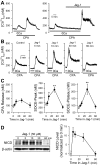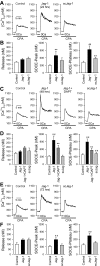Activation of Notch signaling by short-term treatment with Jagged-1 enhances store-operated Ca(2+) entry in human pulmonary arterial smooth muscle cells
- PMID: 24573085
- PMCID: PMC4010807
- DOI: 10.1152/ajpcell.00221.2013
Activation of Notch signaling by short-term treatment with Jagged-1 enhances store-operated Ca(2+) entry in human pulmonary arterial smooth muscle cells
Abstract
Notch signaling plays a critical role in controlling proliferation and differentiation of pulmonary arterial smooth muscle cells (PASMC). Upregulated Notch ligands and Notch3 receptors in PASMC have been reported to promote the development of pulmonary vascular remodeling in patients with pulmonary arterial hypertension (PAH) and in animals with experimental pulmonary hypertension. Activation of Notch receptors by their ligands leads to the cleavage of the Notch intracellular domain (NICD) to the cytosol by γ-secretase; NICD then translocates into the nucleus to regulate gene transcription. In this study, we examined whether short-term activation of Notch functionally regulates store-operated Ca(2+) entry (SOCE) in human PASMC. Treatment of PASMC with the active fragment of human Jagged-1 protein (Jag-1) for 15-60 min significantly increased the amplitude of SOCE induced by passive deletion of Ca(2+) from the intracellular stores, the sarcoplasmic reticulum (SR). The Jag-1-induced enhancement of SOCE was time dependent: the amplitude was maximized at 30 min of treatment with Jag-1, which was closely correlated with the time course of Jag-1-mediated increase in NICD protein level. The scrambled peptide of Jag-1 active fragment had no effect on SOCE. Inhibition of γ-secretase by N-[N-(3,5-difluorophenacetyl-L-alanyl)]-S-phenylglycine t-butyl ester (DAPT) significantly attenuated the Jag-1-induced augmentation of SOCE. In addition to the short-term effect, prolonged treatment of PASMC with Jag-1 for 48 h also markedly enhanced the amplitude of SOCE. These data demonstrate that short-term activation of Notch signaling enhances SOCE in PASMC; the NICD-mediated functional interaction with store-operated Ca(2+) channels (SOC) may be involved in the Jag-1-mediated enhancement of SOCE in human PASMC.
Keywords: Jagged; Notch intracellular domain; Notch receptor; pulmonary artery; smooth muscle; store-operated calcium entry.
Figures




Similar articles
-
Notch Activation of Ca(2+) Signaling in the Development of Hypoxic Pulmonary Vasoconstriction and Pulmonary Hypertension.Am J Respir Cell Mol Biol. 2015 Sep;53(3):355-67. doi: 10.1165/rcmb.2014-0235OC. Am J Respir Cell Mol Biol. 2015. PMID: 25569851 Free PMC article.
-
Hypoxia selectively upregulates cation channels and increases cytosolic [Ca2+] in pulmonary, but not coronary, arterial smooth muscle cells.Am J Physiol Cell Physiol. 2018 Apr 1;314(4):C504-C517. doi: 10.1152/ajpcell.00272.2017. Epub 2018 Jan 3. Am J Physiol Cell Physiol. 2018. PMID: 29351410 Free PMC article.
-
Notch enhances Ca2+ entry by activating calcium-sensing receptors and inhibiting voltage-gated K+ channels.Am J Physiol Cell Physiol. 2020 May 1;318(5):C954-C968. doi: 10.1152/ajpcell.00487.2019. Epub 2020 Mar 18. Am J Physiol Cell Physiol. 2020. PMID: 32186932 Free PMC article.
-
Role of Store-Operated Ca2+ Entry in the Pulmonary Vascular Remodeling Occurring in Pulmonary Arterial Hypertension.Biomolecules. 2021 Nov 27;11(12):1781. doi: 10.3390/biom11121781. Biomolecules. 2021. PMID: 34944425 Free PMC article. Review.
-
Blockade of Jagged/Notch pathway abrogates transforming growth factor β2-induced epithelial-mesenchymal transition in human retinal pigment epithelium cells.Curr Mol Med. 2014 May;14(4):523-34. doi: 10.2174/1566524014666140331230411. Curr Mol Med. 2014. PMID: 24694299 Review.
Cited by
-
Pathophysiology and pathogenic mechanisms of pulmonary hypertension: role of membrane receptors, ion channels, and Ca2+ signaling.Physiol Rev. 2023 Jul 1;103(3):1827-1897. doi: 10.1152/physrev.00030.2021. Epub 2022 Nov 24. Physiol Rev. 2023. PMID: 36422993 Free PMC article. Review.
-
Notch Activation of Ca(2+) Signaling in the Development of Hypoxic Pulmonary Vasoconstriction and Pulmonary Hypertension.Am J Respir Cell Mol Biol. 2015 Sep;53(3):355-67. doi: 10.1165/rcmb.2014-0235OC. Am J Respir Cell Mol Biol. 2015. PMID: 25569851 Free PMC article.
-
Hypoxia selectively upregulates cation channels and increases cytosolic [Ca2+] in pulmonary, but not coronary, arterial smooth muscle cells.Am J Physiol Cell Physiol. 2018 Apr 1;314(4):C504-C517. doi: 10.1152/ajpcell.00272.2017. Epub 2018 Jan 3. Am J Physiol Cell Physiol. 2018. PMID: 29351410 Free PMC article.
-
A Notch positive feedback in the intestinal stem cell niche is essential for stem cell self-renewal.Mol Syst Biol. 2017 Apr 28;13(4):927. doi: 10.15252/msb.20167324. Mol Syst Biol. 2017. PMID: 28455349 Free PMC article.
-
Astragaloside IV attenuates hypoxia‑induced pulmonary vascular remodeling via the Notch signaling pathway.Mol Med Rep. 2021 Jan;23(1):89. doi: 10.3892/mmr.2020.11726. Epub 2020 Nov 25. Mol Med Rep. 2021. PMID: 33236156 Free PMC article.
References
-
- Campos AH, Wang W, Pollman MJ, Gibbons GH. Determinants of Notch-3 receptor expression and signaling in vascular smooth muscle cells: implications in cell-cycle regulation. Circ Res 91: 999–1006, 2002 - PubMed
-
- Chigurupati S, Venkataraman R, Barrera D, Naganathan A, Madan M, Paul L, Pattisapu JV, Kyriazis GA, Sugaya K, Bushnev S, Lathia JD, Rich JN, Chan SL. Receptor channel TRPC6 is a key mediator of Notch-driven glioblastoma growth and invasiveness. Cancer Res 70: 418–427, 2010 - PubMed
-
- Crosnier C, Attie-Bitach T, Encha-Razavi F, Audollent S, Soudy F, Hadchouel M, Meunier-Rotival M, Vekemans M. JAGGED1 gene expression during human embryogenesis elucidates the wide phenotypic spectrum of Alagille syndrome. Hepatology 32: 574–581, 2000 - PubMed
-
- Doi H, Iso T, Shiba Y, Sato H, Yamazaki M, Oyama Y, Akiyama H, Tanaka T, Tomita T, Arai M, Takahashi M, Ikeda U, Kurabayashi M. Notch signaling regulates the differentiation of bone marrow-derived cells into smooth muscle-like cells during arterial lesion formation. Biochem Biophys Res Commun 381: 654–659, 2009 - PubMed
Publication types
MeSH terms
Substances
Grants and funding
LinkOut - more resources
Full Text Sources
Other Literature Sources
Research Materials
Miscellaneous

